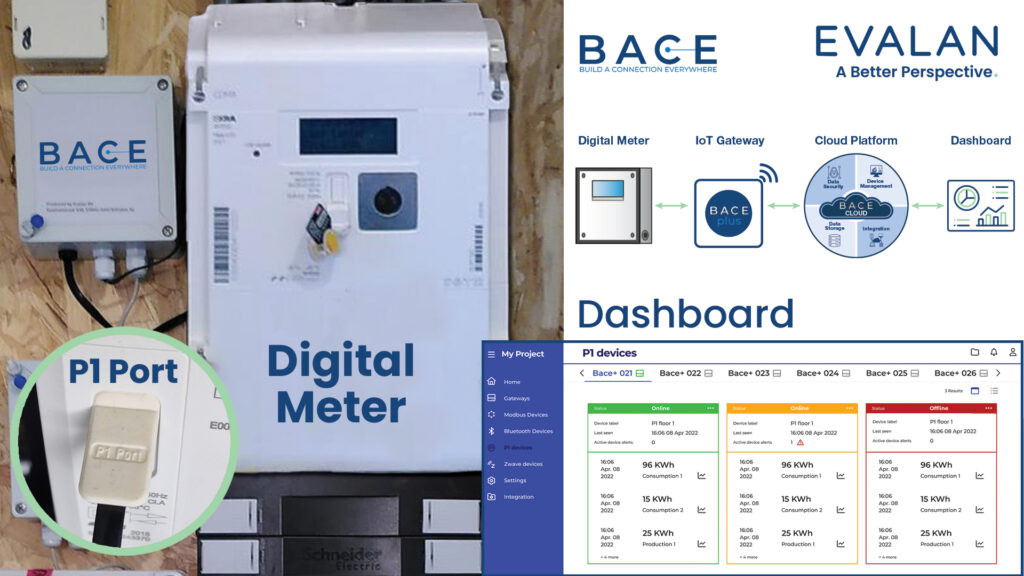Since the Dutch government decided to rollout digital meters to every home, a public debate involving several stakeholders has been going on. In that sense —and as the trend towards smart homes and renewable energy continues to grow— most people in the Benelux region have, by now, heard about P1.
For some, this might have led to a Google search of terms like P1 monitor, P1 meter or P1 gateway to understand what P1 really is, how it came about, what its aim is, and how it can be used to their advantage?
Those and other frequently asked questions will be addressed in this article that aims to demystify the energy management conversation happening around P1.
Index
How do you read P1, and can you read it yourself?
What is P1?
P1 is a serial communication protocol used to communicate between digital meters and data collecting systems like P1 monitors and Internet of Things (IoT) gateways.
P1 was instituted as a standard for energy meters by the Dutch government so that everyone could have access and visibility into their energy consumption through the physical P1 port connector type RJ12 installed in digital energy meters.
The protocol was named after the physical connector and created based on the Dutch Norm (NEN) IEC 62056-21 (Direct local Data exchange for meter reading, tariff, and load control) Mode D (in ASCII).
“The original idea of the P1 standard was to give better insight to everyone about their energy consumption and usage.”
What does P1 measure?
In the Netherlands, connecting a “listening device” to the P1 serial port of digital meters —also known as the consumer port— provides access to real-time measurements and information about the ongoing and aggregated electricity consumption and gas consumption. In other countries of the Benelux region, measurements about water consumption can also be transmitted.
This “listening device” can be a P1 monitor, an IoT gateway, a datalogger or any other device that can read, interpret, and display the data transmitted by the digital meter through the P1 port. Said data may include information such as current and voltage readings, power usage, and other energy-related metrics.
How do you read P1, and can you read it yourself?
P1 communicates in structured telegrams, which are half duplex meaning that they consist of a start bit, 8 data bits, no parity bit and one stop bit.
The block of data starts with a slash (/) followed by a 3-digit model specific identifier, then a 5 and another 3-digit device ID, to then show the data itself ending with an exclamation mark (!), which is then followed by a CRC (Cyclic Redundancy Check) code.

To be able to read the P1 communication protocol yourself from the digital meter, you need to have the necessary expertise and/or equipment, meaning software or a device that can interpret the data. Metering data is forwarded through the P1 port to a data collecting system at an interval of once every 10 seconds for electricity and every hour for gas.
In that sense —and since most people do not have the expertise to create specialized software— devices that process the data from the meter are commercially available. These include the so called P1 monitors and other IoT gateways, which can be seamlessly connected to the serial port.
What is a P1 Monitor?
Digital meters do not store electricity, gas, or water measurements, and the energy usage information offered by distributors and utility providers through their websites is not detailed enough for users to learn about their energy consumption dynamics nor to identify opportunities for energy savings. Which is why consumers that want to have detailed insights and see near real time data use the P1 port.
A P1 monitor is a device that gathers and displays the data transmitted by the digital meter through the P1 port. To do that, the P1 monitor is connected to the digital meter P1 port to then display the energy consumption information in a user-friendly format, such as a web interface or an app, thus allowing the user to track their energy usage in real time, analyze it, and monitor changes over time.
P1 monitors are becoming increasingly popular among home users, as are multi-protocol IoT gateways among businesses that seek to monitor, manage, and trigger automations in several devices in their facility to optimize their energy usage.

BACE IoT: More than just P1
Energy savings and energy management start with monitoring. Behaviors and habits can only be adjusted once someone is aware of the times of day when they are using the most energy or know which assets constitute their main consumption. For example, one may decide to charge an EV vehicle or start energy intensive assets at a different time based on price fluctuations.
With the BACE IoT Gateway you can go beyond monitoring your consumption through the P1 port, as BACE will allow you to control and manage other devices remotely —including Modbus, low-energy wireless, and Z-Wave devices— from a single IoT platform, thus leading to increased energy savings.
With BACE you will be able to track the performance of renewable energy systems, and manage them by ensuring, for example, that the surplus energy of your solar installation is used on-site or by controlling the energy flow from the solar installations to the storage system for later use based on hourly price fluctuations, rather than sending it back to the grid.
More information
Send us an email to info@evalan.com.
Or book a meeting with one of our sales managers here.

